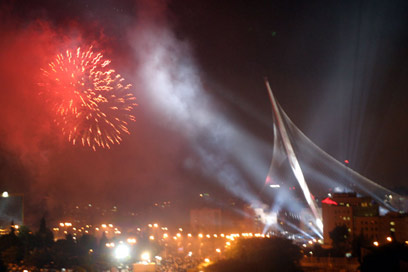
Preparing for event
Photo: AP

Hundreds yelled 'boo' at Olmert
Photo: AP
A ship's sail, a crooked nail, or a giant headache – Jerusalemites can't agree about how best to describe the newest landmark the capital city was inaugurating Wednesday. The $73 million bridge, designed by the Spanish architect and engineer Santiago Calatrava, has suddenly become the most dominant shape on the historic city's skyline.
Water Under Bridge?
Ronen Medzini
Building of new Chords Bridge in capital's entrance enrages Jerusalem councilmen as final stages of construction reportedly performed on Shabbat with mayor's approval. Contractor says incident was 'severe mistake,' denies Lupolianski had prior knowledge
The ceremony marking its opening hosted Prime Minister Ehud Olmert, Jerusalem's Mayor Uri Lupolianski, and Traffic Minister Shaul Mofaz. Some embarrassment ensued when, during Olmert's speech, hundreds of participants called out "boo". This was apparently due to the mixed feelings Jerusalem's residents have about the bridge.
Calatrava's bridge is a flamboyant departure for a city whose famous architecture was provided by people like King Herod and Suleiman the Great and where most modern construction is functional and uninspiring. It has a hard act to follow, joining world-famous landmarks like the 1,300-year-old golden cap of the Dome of the Rock mosque and the stones of the Western Wall, which date back two millennia.
Architect Ami Ran, who edits the "Architecture of Israel" quarterly, criticized the structure as a "monster." He said it "expresses the ego of the architect and not city of Jerusalem itself."

Ceremony lights up capital. (Photo: Oren Rosenfeld)
An informal survey of residents Wednesday found them generally positive about the new addition, if unsure quite what to compare it to. "From everywhere in the city, it looks like a giant crooked nail," cafe owner Yaron Kortik said.
Ran Yaakov, 17, a high school student, said the bridge reminded him of "David's harp," referring to the Biblical monarch and musician. Evyatar Tzuberi, 23, thought it looked like a ship's sail. 19-year-old Orlie Marin compared it to a spider's web.
At a news conference ahead of the opening Wednesday, Calatrava said the structure's strength came from the fact that it is "120 percent modern" and yet has a "dialogue" with the rest of the city. "The most important aspect of the bridge is being in Jerusalem," said Calatrava, who designed the "Turning Torso" Building in Malmo, Sweden and is behind the planned transportation hub at Ground Zero in New York.

City suffers massive traffic jams. (Photo: Israel Bardugo)
Some of the bridge's massive steel components were cast in Italy, shipped to Israel and then brought up to Jerusalem on flatbed trucks. Raising the central spire required the tallest crane in Israel.
Originally planned as a simpler concrete bridge costing $30 million, the bridge turned into a major project to reshape a charm-less part of the city characterized by grimy apartment blocks and hotels. Possibly realizing that its surroundings might not do it justice, City Hall put out a colorful pamphlet with a computer-simulated image of the bridge in the future, nicely accented by two modern high-rises that do not yet exist.
Besides aesthetic arguments, complaints so far have been related to the budget, which critics charged could have been better spent elsewhere, and to the traffic snarls the bridge has caused, which included a 10-hour closure of some of the city's main routes for the gala opening.
"This bridge is just one giant headache," said Ilan Cohen, 27, who was standing at a snack stand not far away.















